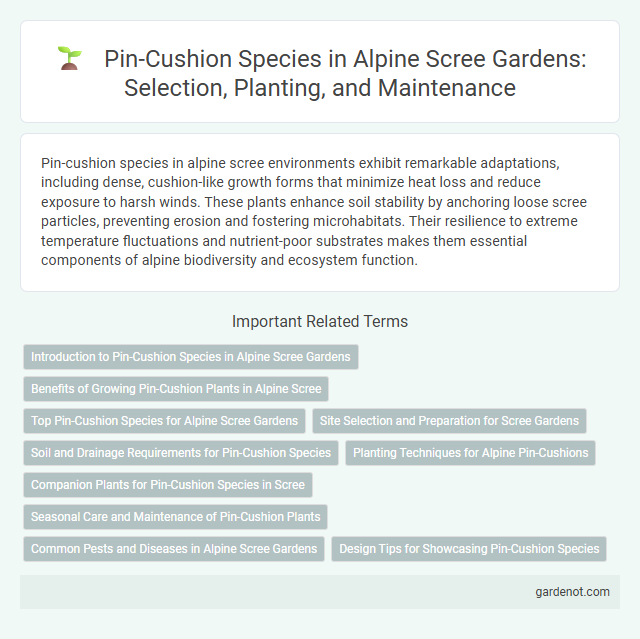Pin-cushion species in alpine scree environments exhibit remarkable adaptations, including dense, cushion-like growth forms that minimize heat loss and reduce exposure to harsh winds. These plants enhance soil stability by anchoring loose scree particles, preventing erosion and fostering microhabitats. Their resilience to extreme temperature fluctuations and nutrient-poor substrates makes them essential components of alpine biodiversity and ecosystem function.
Introduction to Pin-Cushion Species in Alpine Scree Gardens
Pin-cushion species in alpine scree gardens exhibit compact, cushion-like growth forms that minimize water loss and withstand harsh mountain conditions. These plants, such as Silene acaulis and Androsace septentrionalis, adapt to rocky, well-drained substrates typical of scree environments. Their dense mats create microhabitats promoting moisture retention and protection against wind erosion, crucial for survival in high-altitude ecosystems.
Benefits of Growing Pin-Cushion Plants in Alpine Scree
Pin-cushion plants, such as species from the genus Silene, thrive in alpine scree by stabilizing loose soil with their dense root systems, reducing erosion and promoting habitat resilience. Their compact growth habit conserves moisture and provides shelter for microfauna, enhancing local biodiversity. Cultivating pin-cushion species in alpine scree also supports pollinators by offering a reliable source of nectar in harsh, nutrient-poor environments.
Top Pin-Cushion Species for Alpine Scree Gardens
Top Pin-Cushion species for alpine scree gardens include the resilient Diapensia lapponica, known for its dense, mat-forming growth that thrives in harsh, well-drained environments. Silene acaulis, or moss campion, is another prime candidate, offering vibrant pink blooms and exceptional drought tolerance suited to rocky slopes. These species excel in harsh alpine scree conditions due to their ability to anchor firmly in loose soil while enduring extreme temperature fluctuations.
Site Selection and Preparation for Scree Gardens
Choosing well-drained, rocky sites with ample sun exposure is essential for cultivating pin-cushion species in alpine scree gardens. Preparation involves creating loose, gritty soil mimicking natural scree, incorporating sand, gravel, and minimal organic matter to prevent water retention. Positioning plants in crevices or raised mounds enhances drainage and replicates their native alpine microhabitats.
Soil and Drainage Requirements for Pin-Cushion Species
Pin-cushion species thrive in well-drained, gritty soils typical of alpine scree environments, where moisture retention is minimal to prevent root rot. These plants require soil with excellent aeration and low organic matter to mimic their natural rocky habitat. Proper drainage is critical, as waterlogged conditions can cause fungal diseases and hinder the plant's survival in high-altitude scree ecosystems.
Planting Techniques for Alpine Pin-Cushions
Alpine pin-cushion species thrive in well-drained, rocky soils with full sun exposure, making scree slopes ideal for their cultivation. Effective planting techniques include using gritty, loamy substrates mixed with sand or fine gravel to mimic natural alpine conditions and ensuring careful placement in crevices or raised beds to facilitate moisture drainage and root aeration. Regular monitoring for moisture levels and protection from excessive summer humidity enhances survival and promotes dense, compact growth characteristic of healthy alpine pin-cushions.
Companion Plants for Pin-Cushion Species in Scree
Companion plants for pin-cushion species in alpine scree include saxifrages, sedums, and alpine avens, which share similar soil drainage and sunlight requirements. These plants enhance microhabitat stability and promote biodiversity by complementing the pin-cushion's cushion-like growth form. Together, they create a resilient plant community adapted to the harsh alpine scree environment.
Seasonal Care and Maintenance of Pin-Cushion Plants
Pin-cushion plants (genus *Diapensia* and related alpine species) thrive in well-drained, rocky alpine scree environments, requiring minimal watering and protection from excessive moisture during winter dormancy. Seasonal care involves careful monitoring to ensure the soil remains slightly dry in colder months, while light shading during peak summer heat prevents leaf scorch. Regular removal of dead foliage and occasional application of a low-nitrogen fertilizer promote healthy growth and vibrant flowering in alpine scree conditions.
Common Pests and Diseases in Alpine Scree Gardens
Pin-cushion plants in alpine scree gardens often face threats from aphids, which can cause distorted growth and attract sooty mold. Root rot, caused by waterlogged conditions, is a common disease due to poor drainage in scree environments. Powdery mildew occasionally affects cushions, leading to reduced photosynthesis and weakened plant health.
Design Tips for Showcasing Pin-Cushion Species
Highlight the vibrant textures and radial symmetry of alpine pin-cushion species by placing them in well-drained rock gardens or scree beds that mimic their natural alpine scree habitat. Use contrasting foliage and sparse planting arrangements to emphasize their compact, cushion-like growth and bright cushion flowers, enhancing visual interest and maintaining healthy airflow. Incorporate natural stones and gravel to replicate alpine scree conditions, ensuring sharp drainage and promoting optimal growth for these resilient mountain plants.
Pin-cushion species Infographic

 gardenot.com
gardenot.com